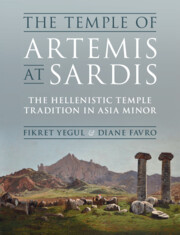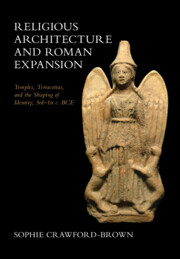Refine search
Actions for selected content:
5894 results in Classical art and architecture
Chapter 2 - Description and Depiction of the Temple by Early Travelers
-
- Book:
- The Temple of Artemis at Sardis
- Published online:
- 30 May 2025
- Print publication:
- 03 July 2025, pp 17-36
-
- Chapter
- Export citation
Chapter 1 - Introduction
-
- Book:
- The Temple of Artemis at Sardis
- Published online:
- 30 May 2025
- Print publication:
- 03 July 2025, pp 1-16
-
- Chapter
- Export citation
Contents
-
- Book:
- The Temple of Artemis at Sardis
- Published online:
- 30 May 2025
- Print publication:
- 03 July 2025, pp vii-xi
-
- Chapter
- Export citation
Frontispiece
-
- Book:
- The Temple of Artemis at Sardis
- Published online:
- 30 May 2025
- Print publication:
- 03 July 2025, pp xii-xii
-
- Chapter
- Export citation
Preface
-
- Book:
- The Temple of Artemis at Sardis
- Published online:
- 30 May 2025
- Print publication:
- 03 July 2025, pp xiii-xvi
-
- Chapter
- Export citation
Chapter 3 - Description of the Building and Archaeology
-
- Book:
- The Temple of Artemis at Sardis
- Published online:
- 30 May 2025
- Print publication:
- 03 July 2025, pp 37-120
-
- Chapter
- Export citation
Plates
-
- Book:
- The Temple of Artemis at Sardis
- Published online:
- 30 May 2025
- Print publication:
- 03 July 2025, pp 293-305
-
- Chapter
- Export citation
Chapter 4 - Building History
-
- Book:
- The Temple of Artemis at Sardis
- Published online:
- 30 May 2025
- Print publication:
- 03 July 2025, pp 121-174
-
- Chapter
- Export citation
Chapter 6 - Issues of Design and Planning: Hellenistic and Roman Temples
-
- Book:
- The Temple of Artemis at Sardis
- Published online:
- 30 May 2025
- Print publication:
- 03 July 2025, pp 199-228
-
- Chapter
- Export citation

The Temple of Artemis at Sardis
- The Hellenistic Temple Tradition in Asia Minor
-
- Published online:
- 30 May 2025
- Print publication:
- 03 July 2025

Religious Architecture and Roman Expansion
- Temples, Terracottas, and the Shaping of Identity, 3rd-1st c. BCE
-
- Published online:
- 06 March 2025
- Print publication:
- 06 March 2025
Abbreviations
-
- Book:
- Religious Architecture and Roman Expansion
- Published online:
- 06 March 2025
- Print publication:
- 06 March 2025, pp xiii-xiv
-
- Chapter
- Export citation
Contents
-
- Book:
- Religious Architecture and Roman Expansion
- Published online:
- 06 March 2025
- Print publication:
- 06 March 2025, pp vii-viii
-
- Chapter
- Export citation
Seven - Conclusion
-
- Book:
- Religious Architecture and Roman Expansion
- Published online:
- 06 March 2025
- Print publication:
- 06 March 2025, pp 231-238
-
- Chapter
- Export citation
Index
-
- Book:
- Religious Architecture and Roman Expansion
- Published online:
- 06 March 2025
- Print publication:
- 06 March 2025, pp 265-272
-
- Chapter
- Export citation
Four - Local Identities and Local Networks
-
- Book:
- Religious Architecture and Roman Expansion
- Published online:
- 06 March 2025
- Print publication:
- 06 March 2025, pp 104-173
-
- Chapter
- Export citation
Works Cited
-
- Book:
- Religious Architecture and Roman Expansion
- Published online:
- 06 March 2025
- Print publication:
- 06 March 2025, pp 239-264
-
- Chapter
- Export citation
Two - Chronological Uncertainties and the “Romanization” Tangle
-
- Book:
- Religious Architecture and Roman Expansion
- Published online:
- 06 March 2025
- Print publication:
- 06 March 2025, pp 31-56
-
- Chapter
- Export citation
Dedication
-
- Book:
- Religious Architecture and Roman Expansion
- Published online:
- 06 March 2025
- Print publication:
- 06 March 2025, pp v-vi
-
- Chapter
- Export citation
Six - Reframing and Remediating
-
- Book:
- Religious Architecture and Roman Expansion
- Published online:
- 06 March 2025
- Print publication:
- 06 March 2025, pp 203-230
-
- Chapter
- Export citation
